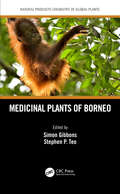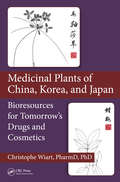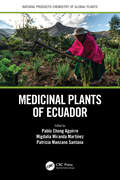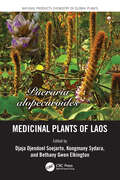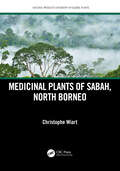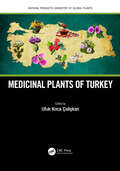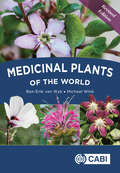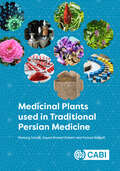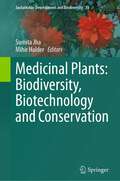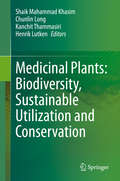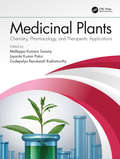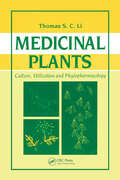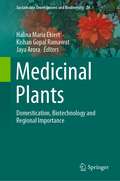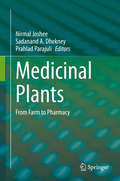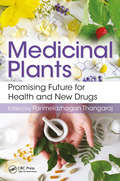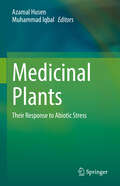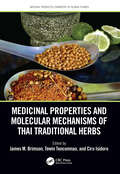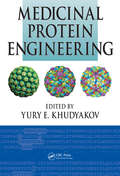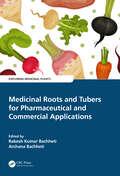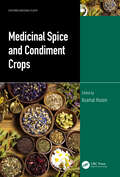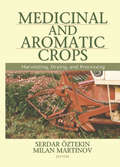- Table View
- List View
Medicinal Plants of Asia and the Pacific
by Christophe WiartDrawing on the author's extensive personal experience, Medicinal Plants of Asia and the Pacific provides comprehensive coverage of the medicinal plants of the region. Describing more than 300 compounds, the book discusses every important class of natural products while highlighting cutting-edge research and recent developments. With its broa
Medicinal Plants of Bangladesh and West Bengal: Botany, Natural Products, & Ethnopharmacology (Natural Products Chemistry of Global Plants)
by Christophe WiartMedicinal Spices of Bengal is a complete compendium. It provides the scientific name, classification, local name(s), historical background, local medicinal uses, botanical description, chemical constituents, pharmacological activity and toxicology of more than 100 medicinal spices used in Bengal. Chemical structures of active constituents are provided as well as numerous references. This book is an indispensable tool for researchers, as well as graduates in various disciplines, including pharmacy, pharmacology, medicine, biotechnology, nutrition, cosmetology and drug development. It is also suitable for anyone who is looking for natural products as leads to be developed in therapeutics, functional nutrition or cosmetology. Focuses on a group of herbs with economic importance – the spices. These herbs demonstrate the richness of chemical diversity and potential pharmacological applications Features field photos with local healers, markets and mode of preparation as well as providing a complete monograph for each plant Discusses the collection and observation of each medicinal spice and presents the ethnopharmacology recorded by the author in Bengal Provides a wealth of scientific information on medicinal spices from an expert in the field Fills an important niche due to the increasing global interests in natural foods and botanical drugs
Medicinal Plants of Borneo (Natural Products Chemistry of Global Plants)
by Simon GibbonsThe rich biodiversity of Borneo provides many useful plants for medicinal purposes. Written by experts in the field, Medicinal Plants of Borneo provides a guide and introduction to the medicinal plants from Borneo used traditionally as well as plants whose medicinal uses have been recently discovered. These include anti-HIV plants – such as Calophyllum lanigerum (calanolide A) – and anti-cancer plants – such as Aglaia foveolata (silvestrol). The book also provides information on the relevant medicinal chemistry, such as isolated bioactive compounds and the mechanism of action, where available. FEATURES Discusses the rich experience in the use of medicinal plants and the wide diversity of Borneo’s botanical resources Presents plants with medicinal properties from a scientific perspective Provides readers with current information on the chemistry and pharmacology of natural products with pharmaceutical potential Covers a range of chemical, botanical and pharmacological diversities Forms an important part of the Natural Products Chemistry of Global Plants series due to an increasing global interest in natural products and botanical drugs Simon Gibbons is Head of the School of Pharmacy, University of East Anglia, UK, and a Professor of Natural Product Chemistry. He was formerly a Professor of Medicinal Phytochemistry at the School of Pharmacy, University College London (UCL). Stephen P. Teo is a forest botanist with the Forest Department, Sarawak, Malaysia.
Medicinal Plants of Central Asia: Uzbekistan and Kyrgyzstan
by David E. Zaurov Lena Struwe Sasha W. EisenmanThis unique book is a collaborative effort between researchers at Rutgers University and colleagues from numerous institutions in Uzbekistan and Kyrgyzstan. It will be the first book to document more than 200 of the most important medicinal plants of Central Asia, many whose medicinal uses and activities are being described in English for the first time. The majority of the plants described grow wild in Central Asia with some being endemic, while other species have been introduced to Central Asia but are commonly used in regional plant based medicine. The book contains four introductory chapters. The first and second chapters cover the geography, climate and vegetation of Kyrgyzstan and Uzbekistan, respectively. The third chapter provides a brief history of medicinal plant use and science in Central Asia and the fourth chapter contains general information about phytochemistry. The fifth chapter comprises the bulk of the book and covers 208 medicinal plant species. Nearly all species have one or more high quality, color photographs. Three useful appendices have been included. The first is a glossary of botanical and ecological terms, the second is a glossary of chemistry terms and the third is a glossary of medical terms. During the preparation of this manuscript we found there to be a deficiency in quality reference resources for the translation of many of the technical terms associated with the different branches of science covered in this book. In order to make our job easier we compiled glossaries over the course of preparing the manuscript and have included them feeling that they will be an extremely valuable resource for readers.
Medicinal Plants of China, Korea, and Japan: Bioresources for Tomorrow's Drugs and Cosmetics
by Christophe WiartAsian medicinal plants show great promise in pharmaceutical and cosmetological development. Researchers engaged in the discovery of new leads in these areas need robust conceptual tools and understanding of interrelated basics of botany, ethnobotany, biomolecular pharmacology, phytochemistry, and medicinal chemistry to guide their investigations. M
Medicinal Plants of Ecuador (Natural Products Chemistry of Global Plants)
by Pablo Chong Aguirre Migdalia Miranda Martínez Patricia Manzano SantanaThis unique volume draws on the rich culture, folklore and environment of medicinal plants in Ecuador, which includes the important rain forest region. This country has rich plant resources and a large diversity of plants. In particular, the Biotechnological Research Center of Ecuador, CIBE, is an important center of plant research and biodiversity. For more than 16 years, CIBE has been performing scientific research on plants and microorganisms with extensive focus on biodiversity, biotechnology, bioproducts, hytopathology, molecular biology, tissue culture and technology transfer. The Center has state-of-the-art infrastructure and technology and a great strength in human resources.
Medicinal Plants of Laos (Natural Products Chemistry of Global Plants)
by Bethany Gwen Elkington Djaja Djendoel Soejarto Kongmany SydaraThis book provides a description of medicinal plants of Laos, including their role in maintaining healthcare among the population, their potential as a source for new medicinal compounds, their preservation, and their importance for the well-being of the communities for present and future generations. The focus of this book is to draw on the rich culture, folklore, and environment of medicinal plants in the country. This is an opportunity to describe medicinal plants from a scientifically underrepresented area, with the hope of making an important contribution to the knowledge of the region for academics, scientists, and anyone who has interest in Laos. Features Describes terrestrial medicinal plants from a scientifically underrepresented region Includes a wider variety of plants found growing in Laos than has previously been published Discusses past and present research on medicinal plants that may lead to the discovery of new medicines Describes efforts in the preservation of these medicinal plants for present and future generations Focuses on the rich culture, folklore, and environment of medicinal plant in Laos Provides an important contribution to knowledge of the region and will benefit anyone interested in the medicinal plants of Laos
Medicinal Plants of Sabah, North Borneo (Natural Products Chemistry of Global Plants)
by Christophe WiartResearchers in the field of natural product chemistry and pharmacology focus on discovering new drugs from medicinal plants. The medicinal plants of Sabah (North Borneo), many of which are found in all of Asia and the Pacific, represent a vast array of resources that could be used for the discovery of drugs and the development of cosmetics as well as functional food. No other book focuses on the medicinal plants from this part of the globe in such depth. The author is well known in natural products and this text will appeal to a global audience in presenting the botanical description, chemical constituents, pharmacology, pharmaceutical, cosmetic, and functional food potentials of these plants.Features: Describes in a phylogenetic order the habitats, distributions, botanical descriptions, local names, uses, chemical constituents, pharmacological activities, and toxic effects of more than 250 species of medicinal plants of Sabah Provides a selection of botanical plates of medicinal plants endemic to Sabah, hand-drawn by the author Provides comment sections to invite further research on the topic of the development of drugs, dietary products, and cosmetics from Sabah medicinal plants
Medicinal Plants of Turkey (Natural Products Chemistry of Global Plants)
by Ufuk Koca ÇalışkanThis book is part of the book series titled Natural Products Chemistry of Global Plants, and examines the rich plant diversity of Turkey, with descriptions of the plants and pharmacognosy properties. There is a focus on the chemistry of natural products and areas rich in folklore and botanical medicinal uses are covered with a particular interest in the region of Anatolia. This book focuses on the chemistry of the natural products, and where possible links these molecules to pharmacological modes of action. Students and professionals interested in the ethnobotany, chemistry, pharmacology and biological activites of species used medicinally in Turkey will benefit from this book. Features Addresses the rich chemistry of the natural products and their respective biosynthetic building blocks Includes the association that many of the extracts have today with important drugs, nutrition products, beverages, perfumes, cosmetics and pigments Describes the key natural products and their extracts, with emphasis on sources, their complex molecules and applications in science Fills a gap in our understanding of medicinal plants, specifically in Turkey Provides an in-depth understanding of medicinal plants from Turkey, and their complex chemistry and structures
Medicinal Plants of the Asteraceae Family: Traditional Uses, Phytochemistry and Pharmacological Activities
by Tariq Aftab Hari Prasad DevkotaThis book highlights 12 major plants in the Asteraceae family from the aspects of traditional uses as food and medicine, phytochemistry, and pharmacological activities. Asteraceae is one of the largest family of flowering plants comprising over 1,600 plant genera and 32,000 plant species. Plants belonging to this family have a long history of being used as medicinal plants for the treatment of various diseases. Many of them are also used in the preparation of foods, beverages, and also used in pharmaceutical and cosmetic industries. In addition, plants such as Artemisia annua have played an important role in the discovery of novel drugs. The book summarizes the traditional uses of the plants in the family Asteraceae and their scientific validation, which helps readers understand their relation and impact on human health. It also explains the Phytochemistry of the species and presents the pharmacological activities and mechanisms in detail. Understanding current scientific knowledge will help in the commercialization of products based on these plants and also helps to find the research gaps that should be fulfilled in the future for their optimal use. It also helps in increasing the awareness of the plant species related to conservation, cultivation, and sustainable utilization. This edited volume comprises chapters contributed by experts from around the world.
Medicinal Plants of the World
by Ben-Erik van Wyk Professor Michael WinkMedicinal plants and plant-derived medicine are widely used in traditional cultures all over the world and they are becoming increasingly popular in modern society as natural alternatives to synthetic chemicals. As more and more natural remedies are being commercialised, there is a need for a user-friendly reference guide to the plants and their products. The book gives the reader a bird's eye view of more than 350 of the best known medicinal plants of the world and their uses, in a compact, colourful and scientifically accurate reference text. It provides quick answers to the most obvious questions: Where does this plant originate? What does it look like? In which culture is it traditionally used? What is it used for? Which chemical compounds does it contain? How safe is it? What is known about its pharmacological activity? What evidence is there that it is effective? The authors also provide short overviews of the various health conditions for which medicinal plants are used and the active compounds (secondary metabolites) found in the plants and their modes of actions. This new edition has an additional 30 plant species, many new and improved photographs and the text has been fully updated to reflect the latest regulatory status of each plant.
Medicinal Plants used in Traditional Persian Medicine
by Roja Rahimi Mamak Hashemi Abadi Maryam Akabery Seyyed Ahmad Askari Sayyedeh Fatemeh Askari Zahra Ayati Sajad Azad Parmis Badr Hamed Baharara Zahra Boghrati Mina Borhani Fatemeh Etemadpour Seyed Majid Ghazanfari Shakila Hajizadeh Bahia Namavar Jahromi Lida Jarahi Mohammad Reza Kanani Seyedeh Mahnaz Karimi Abdolali Mohagheghzadeh Leila Mohtashami Ghazaleh Mosleh Nayebzadeh Motahare Maryam Nikoosokhan Zahra Taghipour Mojgan Tansaz Meysam Zaeri Elaheh Zibaee Roodabeh Bahramsoltani Amir Hossein AbdolghaffariMedicinal plants and the natural products within them, still remain the starting point for breakthroughs in the development of safe, pharmacologically active synthetic molecules for use in a wide variety of clinical situations. Traditional Persian Medicine (TPM) is one of the most ancient medical doctrines, and is well-documented in terms of information about diseases, diagnoses and treatments, especially in the application of medicinal plants. TPM has been used for centuries worldwide, and many of these methods are still used in Iran today. The book introduces the basics of TPM, and describes the key medicinal plants used for the treatment of different diseases. It also highlights possible new targets for research activities in drug discovery of natural products. The book is richly illustrated with historic drawings from old Persian pharmacopoeia and photos of plants in their natural habitats. Reference to Ayurvedic, Traditional Chinese Medicine and monastic medicine in Europe are also made. While knowledge about medicinal plants used in TPM still exists in Iran there is a risk that the detailed expertise provided by older generations will be lost in the near future. It is therefore very important that this cultural heritage is properly preserved. This book provides a valuable, evidence-based resource on TPM for researchers, practitioners and students in medicinal plants, ethnobotany and herbal medicine.
Medicinal Plants: Biodiversity, Biotechnology and Conservation (Sustainable Development and Biodiversity)
by Sumita Jha Mihir HalderThis contributed volume provides a comprehensive, in-depth and subject-based reviews on the current status of active ingredients, sustainable use, biodiversity and conservation of certain endangered medicinal plants. The book also explores conventional and non-conventional biotechnological interventions for their biodiversity conservation. Medicinal plants have been used in worldwide as a major source of raw material for the traditional herbal healthcare practices as well as for drug discovery and development in pharmaceutical industry. The cumulative consequences of various human activities and environmental factors cause decline in the biodiversity of medicinal plants at an unprecedented rate worldwide. Thus, the overall understanding of ecology, species and genetic diversity along with assessment of the status of different threats and their impact on medicinal plants is crucial to sustain existing biodiversity, its utilization and conservation. All the latest advancements in the biotechnological approaches for the conservation research of endangered medicinal plants and the future perspectives have been described. This book provides comprehensive reviews spreading over about 25 chapters divided in three sections. The chapters of this book are written by recognized scientists in their respective fields which are useful to students, academicians, researchers, botanists, biotechnologists, policy makers, conservationists and industries interested in biodiversity conservation and medicinal plant research for the production of secondary metabolites.
Medicinal Plants: Biodiversity, Sustainable Utilization and Conservation
by Shaik Mahammad Khasim Kanchit Thammasiri Chunlin Long Henrik LutkenPlants have been a source of medicines and have played crucial role for human health. Despite tremendous advances in the field of synthetic drugs and antibiotics, plants continue to play a vital role in modern as well as traditional medicine across the globe. In even today, one-third of the world’s population depends on traditional medicine because of its safety features and ability to effectively cure diseases. This book presents a comprehensive guide to medicinal plants, their utility, diversity and conversation, as well as biotechnology. It is divided into four main sections, covering all aspects of research in medicinal plants: biodiversity and conservation; ethnobotany and ethnomedicine; bioactive compounds from plants and microbes; and biotechnology. All sections cover the latest advances. The book offers a valuable asset for researchers and graduate students of biotechnology, botany, microbiology and the pharmaceutical sciences. It is an equally important resource for doctors (especially those engaged in Ayurveda and allopathy); the pharmaceutical industry (for drug design and synthesis); and the agricultural sciences.
Medicinal Plants: Chemistry, Pharmacology, and Therapeutic Applications
by Jayanta Kumar Patra Mallappa Kumara Swamy Gudepalya Renukaiah RudramurthyThis book details several important medicinal plants, their occurrence, plant compounds and their chemical structures, and pharmacological properties against various human diseases. It also gives information on isolation and structural elucidation of phytocompounds, bio-assays, metabolomic studies, and therapeutical applications of plant compounds.
Medicinal Plants: Culture, Utilization and Phytopharmacology
by Thomas S. LiMedicinal Plants: Culture, Utilization and Phytopharmacology covers over 400 species. Each chapter gathers valuable information from a wide variety of sources, and supplies it to the user in convenient table format, arranged alphabetically by scientific name, followed by the common name. Data topics include: major constituents (active ingredients)
Medicinal Plants: Domestication, Biotechnology and Regional Importance (Sustainable Development and Biodiversity #28)
by Kishan Gopal Ramawat Halina Maria Ekiert Jaya AroraMedicinal plant research is an evergreen subject. There is a tremendous increase in popularity of herbal medicine in traditional medicine, ethnomedicine, modern medicine and as over the counter food supplements. Even after this increased demand, supply is neither uniform nor assured as most of these plants are collected from wild. In developing countries of tropical and subtropical regions where majority of herbal drugs are produced, this is not organised sector making it vulnerable to several malpractices, hence standardization of all aspects required. This has also negative impact on biodiversity and conservation of plants as well as supply of uniform material. This book is aimed to provide up to date information about sustainable use of selected medicinal plants, their active ingredients and efforts made to domesticate them to ensured uniform supply. Development of agrotechnology, biotechnology and cultivation practices using conventional and non-conventional methods are presented. Where these efforts will lead the medicinal plant research and future perspective are discussed. The chapters are written by well recognised group leaders in working in the field. The book contains topics on general biology of medicinal plants, their sustainable use and, cultivation and domestication efforts. A uniform chapter structure has been designed to keep consistency. The book will be useful for academicians, agriculturists, biotechnologists and researcher, and industries involved in manufacturing herbal drugs and supplementary products.
Medicinal Plants: From Farm to Pharmacy
by Nirmal Joshee Sadanand A. Dhekney Prahlad ParajuliThis book offers a fresh look on a variety of issues concerning herbal medicine - the methods of growing and harvesting various medicinal plants; their phytochemical content; medicinal usage; regulatory issues; and mechanism of action against myriad of human and animal ailments. ‘Medicinal Plants: From Farm to Pharmacy’ comprises chapters authored by renowned experts from academics and industry from all over the world. It provides timely, in-depth study/analysis of medicinal plants that are already available in the market as supplements or drug components, while also introducing several traditional herbs with potential medicinal applications from various regions of the world. The book caters to the needs of a diverse group of readers: plant growers, who are looking for ways to enhance the value of their crops by increasing phytochemical content of plant products; biomedical scientists who are studying newer applications for crude herbal extracts or isolated phytochemicals; clinicians and pharmacologists who are studying interactions of herbal compounds with conventional treatment modalities; entrepreneurs who are navigating ways to bring novel herbal supplements to the market; and finally, natural medicine enthusiasts and end-users who want to learn how herbal compounds are produced in nature, how do they work and how are they used in traditional or modern medicine for various disease indications.
Medicinal Plants: Promising Future for Health and New Drugs
by Parimelazhagan ThangarajThis book highlights the importance of traditional medicines, focuses on the standardization of herbal medicine and evaluates opportunities for advancing drug research. It addresses issues in utilization of medicinal plants and shares the importance of herbs in neutraceutics. It provides most competitive techniques being used in research.
Medicinal Plants: Their Response to Abiotic Stress
by Muhammad Iqbal Azamal HusenThis book provides a comprehensive overview of medicinal plants and their interaction with abiotic stress in terms of morphological, physiological, biochemical, and molecular variations, and explains the adaptation and tolerance mechanisms involved. It presents various mechanisms that become operative in medicinal plants to combat stressful situations. The book discusses the secondary metabolites and/or bioactive compounds produced in medicinal plants under abiotic stress conditions, and the use of biostimulants and/or phytoprotectants to alleviate the adverse effects of abiotic stresses on medicinal plants. Additionally, it is likely to address opportunities and challenges in molecular and omics studies of medicinal plants under abiotic stress conditions. Overall, the chapters are developed by eminent subject experts with due care and clarity and cover an up-to-date literature review with relevant illustrations. The book would cater to the need of graduate and post-graduate students, researchers as well as scientists, and may attract the attention of pharmaceutical companies/industrialists and health policymakers.
Medicinal Properties and Molecular Mechanisms of Thai Traditional Herbs (Natural Products Chemistry of Global Plants)
by James M. Brimson, Tewin Tencomnao, and Ciro IsidoroWith a focus on the unique cultural and ecological of aspects of Thailand, this latest title in the popular series, Natural Products Chemistry of Global Plants, offers invaluable insights for researchers and healthcare professionals interested in exploring the potential of Thai herbal medicines in the broader context of global health and wellness. It also appeals to individuals seeking natural and traditional alternatives to modern medicine. The book provides a bridge between modern pharmacology and traditional medicinal practices, thereby bringing Thai traditional herbal medicines into the mainstream, while giving a critical explanation of their efficacy and safety.
Medicinal Protein Engineering
by Yury E. KhudyakovAn All-Inclusive Review of the Achievements and Trends in the Fast-Growing Protein Engineering Field From humble beginnings like making fire for mere survival, engineering now steadfastly penetrates all aspects of our lives and even life itself at the molecular level. Protein engineering is a molecular biological discipline focused on designing and
Medicinal Roots and Tubers for Pharmaceutical and Commercial Applications (Exploring Medicinal Plants)
by Rakesh Kumar Bachheti and Archana BachhetiThe root and tuber are vital parts of medicinal plants providing mechanical support, producing critical growth regulators, and storing food. Bioactive compounds obtained from plant roots and tubers demonstrate health benefits presenting antioxidative, antimicrobial, hypoglycaemic, hypocholesterolaemic, and immunomodulatory properties. Roots of many medicinal plants have been used for the treatment of disease and formulation of drugs, and they are also known for their commercial value, being used as an ingredient in the pharmaceutical and cosmetic industries. Medicinal Roots and Tubers for Pharmaceutical and Commercial Applications provides information on the medicinal properties of roots and tubers and various phytochemicals derived from them. Features Presents exhaustive information on plant roots and tubers including Glycyrrhiza glabra, Curcuma longa, Beta vulgaris, Zingiber officinalis, Boesenbergia pandurata, Houttuynia cordata, Eutrema japonicum, and Withania somnifera Explains the roles of secondary metabolites isolated from roots and tubers and features information on their pharmaceutical and commercial applications Discusses opportunities for future prospects of different roots and tubers for their industrial applications A volume in the Exploring Medicinal Plants series, this book provides information on phytochemicals derived from medicinal plant roots and tubers. This is valuable information for scientists, researchers, and students working on medicinal plants, economic botany, chemistry, biotechnology, pharmaceuticals, and many other interdisciplinary subjects.
Medicinal Spice and Condiment Crops (Exploring Medicinal Plants)
by Azamal HusenSpices are used in small quantities to add flavor, aroma, color, and texture in food preparation. However, spices and condiments have also been recognized as having medicinal value. They have been used traditionally as curative and preventive agents, the bioactive compounds obtained from these plants are used in herbal drug formulations in modern times. Medicinal Spice and Condiment Crops provides a comprehensive overview on the medicinal properties of spices and condiments with focus on various phytochemicals derived from them.KEY FEATURES:• Examines spices and condiments with respect to their biology, diversity, distribution, and pharmacological values.• Explores the scientific validations of the therapeutic potentials of spice and condiment plant species.• Discusses the bioactive agents involved in alleviating symptoms of cardiovascular disease, cancer, diabetes, ulcers, skin disorders, and neurodegenerative diseases.• Explains specific medicinal features of spice and condiment-producing plant species inspiring research, discovery, and safe herbal drug formulation.A volume in the Exploring Medicinal Plants series, this book is useful for plant scientists, economic botanists, those who work with herbal and complementary medicine, as well as people working in the pharmaceutical industry.
Medicinal and Aromatic Crops: Harvesting, Drying, and Processing
by Serdar Oztekin Milan MartinovMake sure your crops are market-ready with the aid of harvest and post-harvest mechanization Medicinal and Aromatic Crops presents harvest and post-harvest mechanization methods for the profitable production of market-ready medicinal crops. This practical handbook includes photos, detailed figures, and schematic drawings of machines tha


